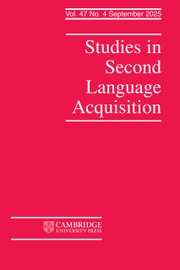Crossref Citations
This article has been cited by the following publications. This list is generated based on data provided by
Crossref.
Mora, Joan C.
and
Valls‐Ferrer, Margalida
2012.
Oral Fluency, Accuracy, and Complexity in Formal Instruction and Study Abroad Learning Contexts.
TESOL Quarterly,
Vol. 46,
Issue. 4,
p.
610.
Piske, Thorsten
2012.
Pragmatics and Prosody in English Language Teaching.
Vol. 15,
Issue. ,
p.
41.
Derwing, Tracey M.
and
Munro, Murray J.
2013.
The Development of L2 Oral Language Skills in Two L1 Groups: A 7‐Year Study.
Language Learning,
Vol. 63,
Issue. 2,
p.
163.
Isaacs, Talia
and
Thomson, Ron I.
2013.
Rater Experience, Rating Scale Length, and Judgments of L2 Pronunciation: Revisiting Research Conventions.
Language Assessment Quarterly,
Vol. 10,
Issue. 2,
p.
135.
DE JONG, NIVJA H.
STEINEL, MARGARITA P.
FLORIJN, ARJEN
SCHOONEN, ROB
and
HULSTIJN, JAN H.
2013.
Linguistic skills and speaking fluency in a second language.
Applied Psycholinguistics,
Vol. 34,
Issue. 5,
p.
893.
O’Brien, Mary Grantham
Jackson, Carrie N.
and
Hendricks, Alison Eisel
2013.
Making use of cues to sentence length in L1 and L2 German*.
Linguistic Approaches to Bilingualism,
Vol. 3,
Issue. 4,
p.
448.
Baker‐Smemoe, Wendy
Dewey, Dan P.
Bown, Jennifer
and
Martinsen, Rob A.
2014.
Does Measuring L2 Utterance Fluency Equal Measuring Overall L2 Proficiency? Evidence From Five Languages.
Foreign Language Annals,
Vol. 47,
Issue. 4,
p.
707.
Pinget, Anne-France
Bosker, Hans Rutger
Quené, Hugo
and
de Jong, Nivja H.
2014.
Native speakers’ perceptions of fluency and accent in L2 speech.
Language Testing,
Vol. 31,
Issue. 3,
p.
349.
O'BRIEN, MARY GRANTHAM
JACKSON, CARRIE N.
and
GARDNER, CHRISTINE E.
2014.
Cross-linguistic differences in prosodic cues to syntactic disambiguation in German and English.
Applied Psycholinguistics,
Vol. 35,
Issue. 1,
p.
27.
Rallo Fabra, Lucrecia
and
Jacob, Karen
2015.
Content-based Language Learning in Multilingual Educational Environments.
Vol. 23,
Issue. ,
p.
163.
Thomson, Ron I.
2015.
The Handbook of English Pronunciation.
p.
209.
2015.
Pronunciation Fundamentals.
Vol. 42,
Issue. ,
DE JONG, NIVJA H.
GROENHOUT, RACHEL
SCHOONEN, ROB
and
HULSTIJN, JAN H.
2015.
Second language fluency: Speaking style or proficiency? Correcting measures of second language fluency for first language behavior.
Applied Psycholinguistics,
Vol. 36,
Issue. 2,
p.
223.
Guz, Ewa
2015.
Establishing the fluency gap between native and non-native-speech.
Research in Language,
Vol. 13,
Issue. 3,
p.
230.
Préfontaine, Yvonne
and
Kormos, Judit
2015.
The Relationship Between Task Difficulty and Second Language Fluency in French: A Mixed Methods Approach.
The Modern Language Journal,
Vol. 99,
Issue. 1,
p.
96.
Simard, Daphnée
Bergeron, Annie
Liu, Yong Gang
Nader, Marie
and
Redmond, Leslie
2016.
Production d’autoreformulations autoamorcées en langue seconde : rôle de l’attention et de la mémoire phonologique.
The Canadian Modern Language Review,
Vol. 72,
Issue. 2,
p.
183.
Crowther, Dustin
Trofimovich, Pavel
and
Isaacs, Talia
2016.
Linguistic dimensions of second language accent and comprehensibility.
Journal of Second Language Pronunciation,
Vol. 2,
Issue. 2,
p.
160.
Grimshaw, Jennica
Cardoso, Walcir
and
Waddington, David
2016.
CALL communities and culture – short papers from EUROCALL 2016.
p.
172.
Guz, Ewa
2016.
Refining the methodology for investigating the relationship between fluency and the use of formulaic language in learner speech.
Research in Language,
Vol. 14,
Issue. 2,
p.
95.
Peltonen, Pauliina
and
Lintunen, Pekka
2016.
Integrating quantitative and qualitative approaches in L2 fluency analysis: A study of Finnish-speaking and Swedish-speaking learners of English at two school levels.
European Journal of Applied Linguistics,
Vol. 4,
Issue. 2,
p.
209.

